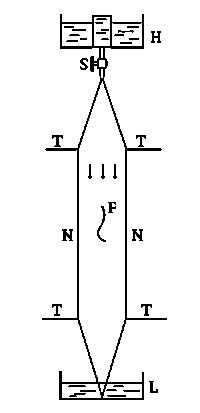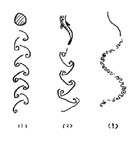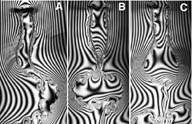| |
Flexible Filaments in Flowing
Soap Film
|
|
| |
We study here the dynamics of
flexible filaments (silk threads) in a flowing soap film. For a
single filament held at its upstream end and otherwise
unconstrained, we found two distinct , stable dynamical states: a
"stretched-straight" state, and a flapping state. The
stretched-straight state is proven experimentally to be linearly
stable. In this state, the filament is immobile and aligned in the
flow direction, and sheds a small von Karman vortex street
downstream from its free end. In the flapping state, the filament
executes a sinuous motion with waves traveling downstream along its
length in a manner akin to the flapping of a flag in the wind. We
also study the side by side interaction between two coupled
filaments. Four different dynamical states are observed, depending
on the distance between the filaments: a steady state, an in-phase
flapping state, an out-of-phase flapping state, and a decoupled
flapping state. [Flexible filaments in a flowing soap film as a
model for one-dimensional flags in a two-dimensional wind. by
Zhang, Childress, Libchaber and Shelley, Nature, 408, 835,
(2000)] |
|
| |
 |
The setup for the flowing soap film: The
typical thickness of the soap film is 3-4 microns and the speed is
about 200 cm/sec. We use the commercial soap "Dawn" and mix it with
distilled water at a 1.5% concentration. The flow can run (on a
good day) for hours without breaking. In this figure, H is the
upper container, S the stopcock which regulates the flux (thus the
flow speed), N the two nylon lines on which the soap film is formed
as it flows, T four tension lines to separate the two nylon lines,
L is the lower container and F the silk filament (exaggerated in
size). |
|
|
| |
| A stretched-straight state: The filament is
stable under small disturbances. A vortex street similar to
von Karman street is shed behind the free end. The filament is
stationary. However, if the external disturbances are big
enough, the filament will jump to a "flapping state" [see
image below] . The flow is visualized with a low pressure sodium
lamp from the interference pattern. The bifurcation from "straight"
to "flapping" state can be shown experimentally to be
subcritical. |
 |
|
|
| |
 |
The flapping state: the filament executes an
oscillatory motion with a wave traveling downstream. The thin wake
generated from the free end is now modified and displaced in
concert with the flapping motion. This state is stable under finite
disturbances, but it can be forced back to the "stretched-straight"
state by holding it taut. |
|
|
| |
| The free end of the filament executes a
"figure-eight " motion due to the fact that the filament is
inextensible and the flapping motion is a traveling wave moving
along in the free stream direction. |
 |
|
|
| |
 |
Comparison of the wakes of (1) cylinder, (2)
fish tail ,and (3) flexible filament. Notice that the vortex
streets are significantly different. |
|
|
| |
| Two filaments are inserted side-by-side in the
running soap film . The interaction is mediated through the fluid.
Two phase-locked states are discovered. In one, both filaments are
flapping in phase, and in the other the filaments flap 180 degrees
out of phase. As the coupling distance is increased, each filament
starts to flap independently. A "stretched-straight" state is also
observed, where both filaments stay stationary (not shown).
|
 |
|
|
| |
"Flexible filaments in a flowing soap film as a model for
one-dimensional flags in a two-dimensional wind"
Zhang, Childress, Libchaber and Shelley
Nature, 408, 835, (2000)
(
Full Text,
PDF - site or personal license required for Nature
on-line):
Some reports related to this
work
|
|
|
|
Back
|





